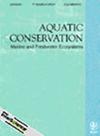Habitat Selection and Negative Effect of River Regulation on the Abundance of the Common Sandpiper (Actitis hypoleucos), a Riparian Shorebird
IF 2.5
3区 环境科学与生态学
Q3 ENVIRONMENTAL SCIENCES
引用次数: 0
Abstract
- Rivers and other freshwater ecosystems have been severely changed by humans. This resulted in a distinct decline in the abundance of many aquatic organisms, as well as those living in water-dependent habitats. Our work aimed to study the habitat selection of breeding common sandpipers (Actitis hypoleucos) and the impact of river regulation on the occurrence of this species.
- Data were collected on a 100-km stretch of the Vistula River, a semi-natural, lowland and large European river. The distribution of birds was determined based on two censuses, while environmental variables were collected based on Sentinel-2 satellite imagery classification, digital elevation model (DEM), digital surface model (DSM) and official data of river regulations.
- The length of the shoreline of either the river or vegetated islands had a positive effect on the number of breeding territories of the common sandpiper. This indicates the importance of the presence of a natural riverbed with a complex shoreline. Moreover, sandpipers preferred islands over the river shores as nesting habitat. River regulations, such as groynes and riprap, had a negative impact on the abundance of breeding common sandpipers even though the river regulation was not intensive. The negative effect has been persisting for many years after the regulation was implemented, despite the degradation of regulatory structures over this period.
栖息地选择和河流调节对河岸滨鸟普通鹬(Actitis hypoleucos)数量的负面影响
人类严重改变了河流和其他淡水生态系统。这导致许多水生生物以及生活在依赖水的栖息地的生物数量明显减少。我们的工作旨在研究繁殖中的普通鹬(Actitis hypoleucos)对栖息地的选择以及河流治理对该物种出现的影响。 我们在维斯瓦河(一条半自然的欧洲低地大河)100 公里的河段上收集了数据。鸟类的分布是根据两次普查确定的,而环境变量则是根据哨兵-2 卫星图像分类、数字高程模型(DEM)、数字地表模型(DSM)和河流管理的官方数据收集的。 河流或有植被岛屿的海岸线长度对杓鹬繁殖地的数量有积极影响。这表明,具有复杂海岸线的天然河床的存在非常重要。此外,与河岸相比,矶鹞更喜欢将岛屿作为筑巢栖息地。尽管河道治理并不密集,但河槽和护岸等河道治理措施对普通鹬的繁殖数量有负面影响。尽管监管结构在此期间有所退化,但这种负面影响在监管实施多年后仍然持续存在。
本文章由计算机程序翻译,如有差异,请以英文原文为准。
求助全文
约1分钟内获得全文
求助全文
来源期刊

Aquatic Conservation-Marine and Freshwater Ecosystems
环境科学-海洋与淡水生物学
CiteScore
5.50
自引率
4.20%
发文量
143
审稿时长
18-36 weeks
期刊介绍:
Aquatic Conservation: Marine and Freshwater Ecosystems is an international journal dedicated to publishing original papers that relate specifically to freshwater, brackish or marine habitats and encouraging work that spans these ecosystems. This journal provides a forum in which all aspects of the conservation of aquatic biological resources can be presented and discussed, enabling greater cooperation and efficiency in solving problems in aquatic resource conservation.
 求助内容:
求助内容: 应助结果提醒方式:
应助结果提醒方式:


